|
|
|
|
 pH's Waterblock Comparison pH's Waterblock Comparison
|
|
Date Posted: Feb 1 2004
|
|
Author: pHaestus
|
|
|
|
|
Posting Type: Review
|
|
Category: H2O and High End Cooling Reviews
|
|
Page: 2 of 2
|
|
Article Rank:No Rank Yet
Must Log In to Rank This Article
|
|
|
|
|
Note: This is a legacy article, imported from old code. Due to this some items on the page may not function as expected. Links, Colors, and some images may not be set correctly.
|
|
|
pH's Waterblock Comparison By: pHaestus
|
|
|
|
|
pHaestus' Waterblock Comparison
Page 2 By: pHaestus 2/01/04
|
|
|
|
Test Results and Observations:
|
|
|
|
|
In my testing of the RBX, I came to some rather different conclusions from most reports I have read online. My experience was that it is quite difficult
to get a good reproducible mount of this waterblock. I threw out 4 mountings that performed 3-5C worse than the average mountings. The reason for this poor reproducibility is the fact that the baseplate of the
waterblock isn't as wide as the pads on an AMD processor.
When the hose is bent (as will be the case in ANY end user's system), then the block will have a tendency to no longer remain flat on the core. I deal with this by having the hose of my test system run perpendicular to the motherboard and parallel to the ground; end users don't have that luxury.
|
|
|
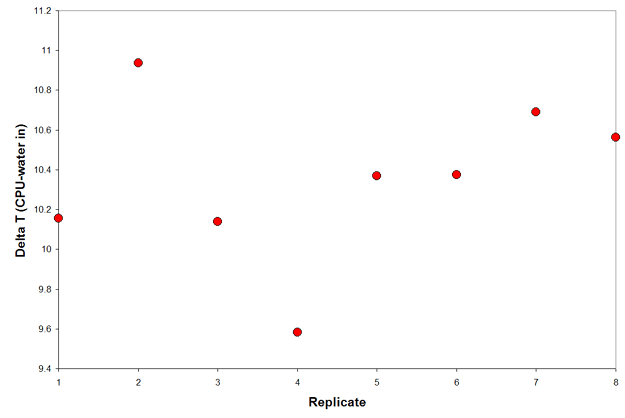 |
|
The problems with mounting could easily have been solved by simply making the block rectangular instead of scalloped, or by even widening the block to
dimensions similar to the Maze4. It's possible that this will only be an issue with AMD processors. Perhaps putting 100 lbs force (P4) rather than 24 (AMD) would be enough to keep the RBX flat on the core.
|
|
|
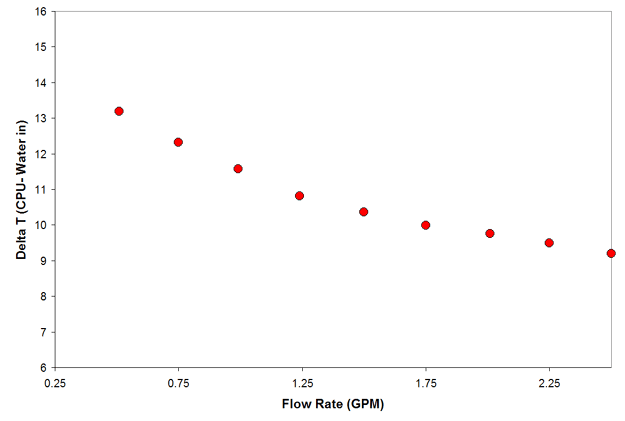 |
|
The RBX is definitely a waterblock that requires a larger pump to perform well.
Its maximum flow rate (loop unrestricted) was around 2.58GPM, which implies that the block is less restrictive than the Whitewater or the Cascade. This will be affected by the choice of RBX inlet nozzle (which I have not yet tested).
|
|
|
I have heard complaints about the baseplate finish on the DTek whitewaters. I have also heard that these finish problems are a thing of the past.
I can't personally tell one way or the other as this block came from nikhsub1 and had been lightly lapped prior to arrival. Dtek sells a poly-top and an aluminum-top whitewater; the aluminum block was tested. I would expect the performance of the aluminum block to be better than the poly-top because the aluminum white water has a middle copper insert that is in contact with the base.
Mounting the White Water was a snap with none of the problems experienced with the RBX. Dangerden really should just use a rectangular design instead of
trying to do something fancy; it simply works better.
|
|
|
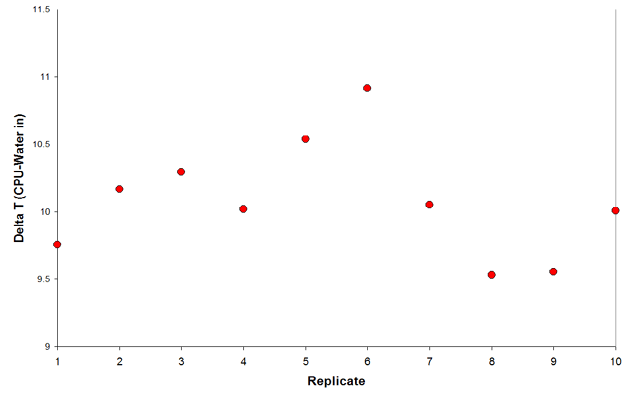 |
|
Flow rate testing of the White Water revealed that it performs somewhat better than the RBX at low flow rates.
The Whitewater doesn't benefit as much from increased (more than 2GPM) flow rates, however. The choice of nozzles is probably the explanation for this behavior. The Whitewater's maximum flow rate was 2.46GPM, which suggests that the inlet on the white water is somewhat more restrictive than the RBX's default nozzle. That would mean water velocity (and die impingement) would be decreased in the RBX compared to the whitewater. The performance boost for the RBX at higher flow rates is probably due to this as well.
|
|
|
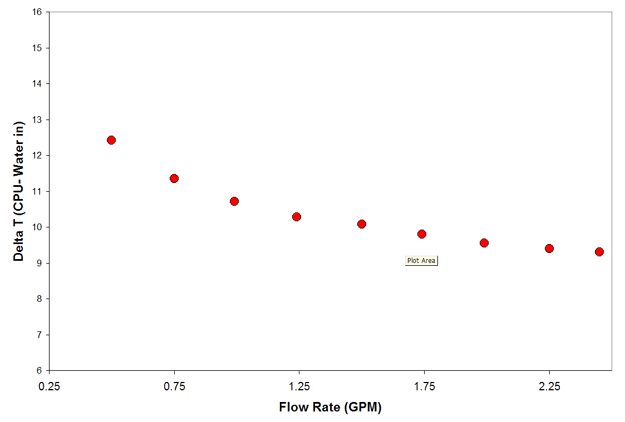 |
|
The fit and finish on this block was outstanding, and I had no difficulties in reproducibly mounting this block.
I DID encounter one issue with the Cascade during testing. When I first installed the Cascade there was a small leak at the inlet barb. I tightened the barb down about ¼ turn, and that was a big mistake. The over-tightening of the barb eventually caused the Cascade top to crack and I managed to soak a video card and motherboard. Cathar had a replacement top shipped to me immediately and offered some advice: Never overtighten barbs in poly tops. Instead you should unscrew them, replace the silicone sealant, and tighten them down again. Seems like good advice to me.
|
|
|
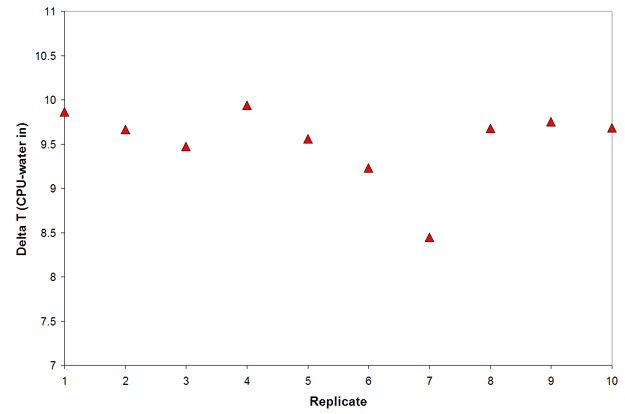 |
|
In general the reproducibility of Cascade mounting was better than the other blocks.
The exception was the one "perfect mount" that performed a full degree better than average. This happens sometimes; leave the block alone when it happens to you!
|
|
|
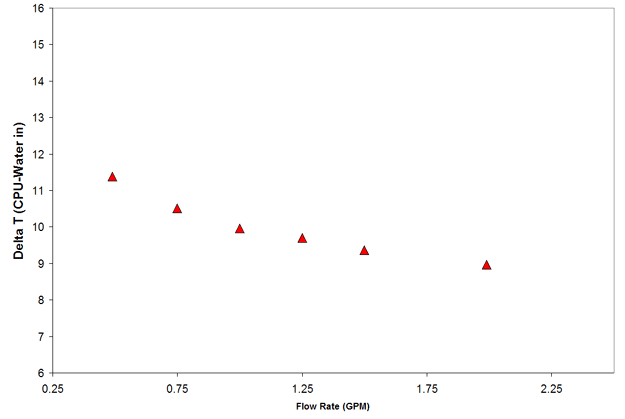 |
|
The low flow rate performance of the Cascade is truly exceptional.
The combination of the Cascade and a very quiet pump (isolated Eheim 1048) should make a good base for a quiet (yet performance-minded) water cooling setup. There is not much room for design improvement over the Cascade; the bar is set very high for competitors.
|
|
|
|
|
|
|
|
|
|
Summary/Conclusion:
|
|
|
The relative performance of these blocks becomes much clearer when they are all graphed together:
|
|
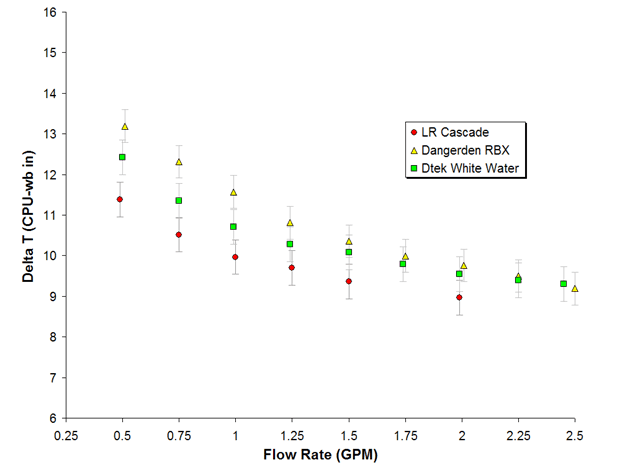 |
|
|
|
The Cascade is clearly the top performing waterblock of this bunch, and its low flow rate (1GPM and below) is amazing. It generally performs about 1C
better than the Whitewater, which is probably why Little River only manufactures Cascades nowadays.
The Dangerden RBX performs reasonably well at very high flow rates, but at flow rates more typical for end users then both the Whitewater and the Cascade are better. It is possible that the RBX will improve with a more restrictive inlet nozzle; further testing is underway. Availability and cost are also an issue with waterblock selection. At the time of this review, the Cascade cost $105, the RBX $51.99, and the DTek Whitewater $59.99. Availaibility of Dangerden waterblocks is typically quite good, while both Dtek and Little River blocks may require a bit of a wait. Cathar has mentioned that he typically produces approximately 15 Cascades per month.
While all the above graphs and discussion may be useful when assembling a complete cooling system, readers may also be interested in "how will these blocks
compare in MY system?"
This is a somewhat complicated question, as the actual flow rate in a loop will vary from block to block. So each block will be at a different point on its "flow rate vs. delta T" graph. The best way to deal with this problem is to collect pressure drop vs. flow rate data along with cooling vs. flow rate, but my digital pressure gauge is broken. It is also possible to do some rough estimates of flow rates given pressure drop data available from JoeC and BillA at Overclockers.com and pump P-Q curves. Cathar ran these numbers in this O/Cers thread, and came up with the following estimates (assuming a Dtek Pro core and the block is used and ½" loop):
|
|
 |
|
|
|
Given that information (and consider the numbers to be at best +/- 0.1GPM), you should be able to make a pretty good guess as to performance in your own loop.
The mounting issues with the RBX make me unable to recommend it for AMD users.
With the 3 barb design, I seriously doubt that you'll be able to get it plumbed into your case without providing some sideways force. That sideways force is most likely going to result in mounting problems and higher temperatures. Neither the Cascade nor the Whitewater suffer from this problem.
Whether one should pay the premium for a Cascade over other good commercial waterblocks is a pretty personal choice.
Personally I place a high premium on efficiency and elegance in design. I was very impressed with the fit, finish, and low flow rate performance of my expensive Innovatek waterblock a year ago, and I am now smitten with my even more expensive Cascade. I have a closet full of good waterblocks given to me by manufacturers and retailers, but I felt the need to buy this Cascade after testing. That should speak volumes.
|
|
|
|
| Random Forum Pic |
 |
| From Thread: My firs attempt at watercooing |
|
| | ProCooling Poll: |
| So why the hell not? |
|
I agree!
|
 67% 67%
|
|
What?
|
 17% 17%
|
|
Hell NO!
|
 0% 0%
|
|
Worst Poll Ever.
|
 17% 17%
|
Total Votes:18Please Login to Vote!
|
|






 pH's Waterblock Comparison
pH's Waterblock Comparison







